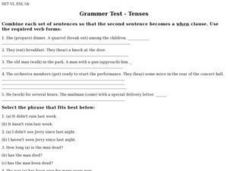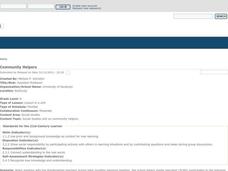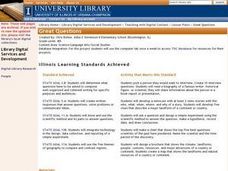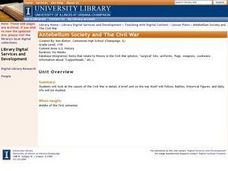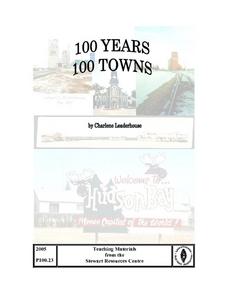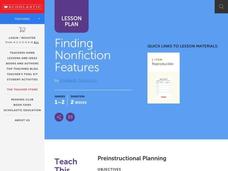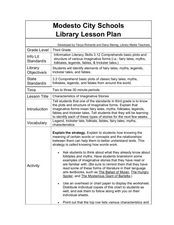Curated OER
Stock Wars: Bringing Wall Street to your Classroom
Using interactive apps and structured assignments, you can make the stock market accessible to all students.
Curated OER
Grammar Test - Tenses
In this grammar worksheet, students complete a variety of activities including combining sentences with a when clause, selecting a grammatically correct phrase out of two and supplying a verb to complete ten sentences.
Curated OER
Pronouns
In this grammar instructional activity, students read twenty-three sentences and circle the correct pronoun in parenthesis. For example, "Your class was a treat for (we, us) students."
Curated OER
Goals, Ideas, and Activities
In this goals and self awareness activity, students complete a set of sentences about their own goals, ideas for the future, activities they enjoy or don't enjoy and people in their lives who can help them reach their goals.
Curated OER
Everybody Cooks Rice
Students read the book, "Everybody Cooks Rice," and they participate in activities pertaining to the book. They identify countries mentioned in the text and locate them on a world map. They use an atlas to identify the climatic...
Curated OER
Passport to Africa
Young scholars begin the instructional activity by reading a novel about the diversity of geography in Africa. They are to create an oral report based on information they research. They also communicate with someone through email about...
Curated OER
Fort Owen: Cultural Crossroad of the Bitterroot Valley
Fourth graders investigate the history of Bitterroot Valley. They conduct research using primary and secondary resources. The analysis of the information is used to discover the true relationship the settlers and native peoples. Then...
Curated OER
Guess Who's Coming to Our Classroom
Students use their research skills to determine the famous person given in clues. Using a character recently dicussed in their classroom, they discuss how they would create a costume for them. They write sentences to be used as dialogue...
Curated OER
Community Helpers
Kindergartners learn who community helpers are and what contributions they make for the community. They will hear a story outlining various community helpers, their jobs, and tools, create a graphic organizer connecting community...
Curated OER
WW II Magazine
Eleventh graders search the database for pictures of WW II, photographs, posters, etc. They use the documents to support writing two magazine articles. The magazine articles be a minimum of 500 and maximum 1000 words.
Curated OER
Algebra I Project: Make Your Own Business
Students explore the concept of algebra in real world situations. In this economics lesson, students design, plan, run, and evaluate a small business. Students will create a product, market the product, and try to make a profit.
Curated OER
Great Questions
Fourth graders research and create questions about a famous person. They create questions in a game format, create a computer generated brochure, and develop rubrics for their finished projects.
Curated OER
People and Their Place in the Community
Third graders search TDC database for images of famous people, such as Rosa Parks, Gandhi, Martin Luther King Jr., etc. They also retrieve information about their accomplishments, time frames, areas, and how they made a difference in...
Curated OER
The Civil War/ A Unit Overview
Eleventh graders will look at the causes of the Civil War in detail. A brief unit on the war itself will follow. Battles, historical figures, and daily life will be studied. The webpage is a link to many different related lessons.
Curated OER
100 Years 100 Towns
Students study Saskatchewan's Centennial by researching the history. They determine how the town celebrates the Centennial and write a report about it based on the given rubric..
Curated OER
Native Plant Research Project
Students study indigenous plants. They examine why they are special, why some might be threatened, by what forces (pollution, habitat destruction), and what else relies on the continued existence of these plants (insects, animals). They...
Curated OER
Exploring Great Salt Lake Ecosystem
Fourth graders determine the Great Salt Lake is a unique, thriving, and diverse ecosystem. They engage in an actual or a virtual field trip. They record field trip, whether actual or virtual, in science lab book or journal and...
Curated OER
Finding Nonfiction Features
Students review the differences between a fiction and non-fiction book. In groups, they use different non-fiction books to identify the eleven features that distinguish it from a fiction book. To end the lesson, they create a chart...
Curated OER
Characteristics of Imaginative Stories
Third graders explore genre characteristics. In this genre literacy lesson, 3rd graders listen to a variety of fiction stories and classify them according to genre. Students identify common features in each genre and complete a chart by...
Curated OER
Food Contributions
Fourth graders make an alphabet book. In this food contributions lesson students identify foods first harvested by indigenous people. Students use the different foods that are still eaten today that were first harvested by indigenous...
Curated OER
Get a Life! Career Exploration
Students use available assessment tools to discover their personality type and corresponding career options. They research two business careers of interest that correspond with their personality type and consider employment requirements...
Shakespeare in American Life
Patriarchy in King Lear and As I Lay Dying
King Lear, “Papa Doc” Duvalier, Colonel Walter E. Kurtz and Anse Bundren? Imagine a unit that examines the tragic hero and patriarchy in King Lear, As I Lay Dying and Apocalypse Now. To liven the brew, learners are asked to include in...
California Polytechnic State University
Australian Geography Unit
At the heart of this resource is a beautifully detailed PowerPoint presentation (provided in PDF form) on the overall physical geography of Australia, basic facts about the country, Aboriginal history, and Australia culture and lifestyle.
Curated OER
Seeds in Fall...Collect Them All!
Classify seeds by attributes such as size, shape and color! Learners classify seeds using a dichotomous key. They identify human behaviors that have a positive impact on preserving seed and plant biodiversity.

